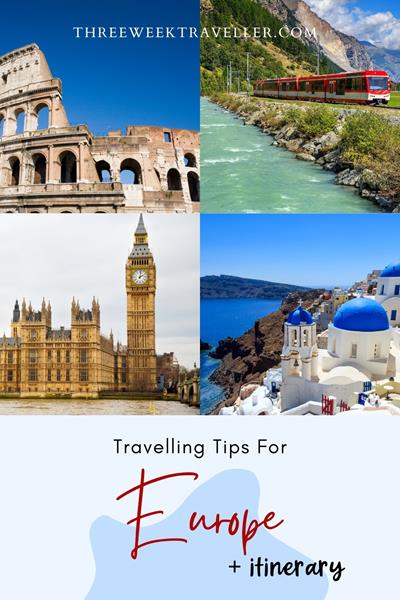I am confident many people have Europe on their bucket list of places to visit. This continent is filled with preserved historical sites, famous landmarks, UNESCO-certified heritage sites, various natural scenery, and diverse cultures from people of different nationalities.
There are tons of activities that you can do here as well. However, if you plan to stay a little longer than the usual vacation duration, it might cost you a lot, especially if you aren’t familiar with places to go without spending too much.
This guide is for people planning to travel around Europe in 3 weeks. Whether you are on a budget or looking to splurge a little, there’s something for everyone. In this guide, I am covering central and southern Europe – both have famous destinations. I also have itineraries for the eastern region for affordable, nordic areas for unique culture, and off-the-beaten path of Europe.
I want to ensure you spend the 3-week holiday that suits you. If you are new to travelling on a budget, check out these tips for budget travel. You can also read in below our estimate of how much a 3-week in Europe trip might cost.
THINGS TO KNOW BEFORE GOING TO EUROPE
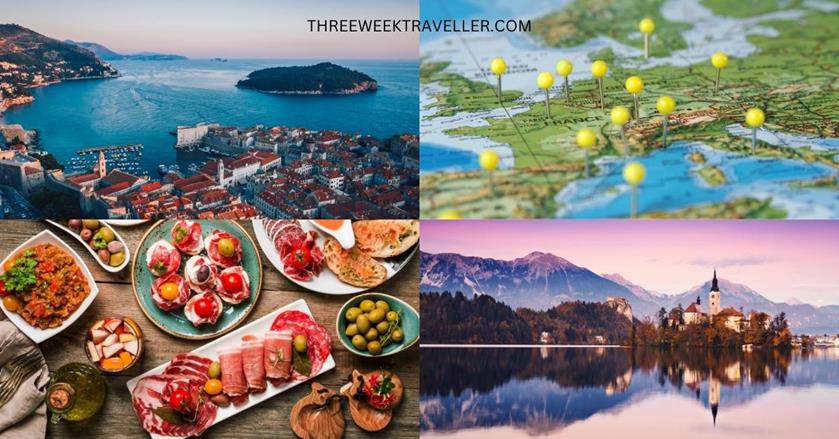
If you plan a trip for 3 weeks in Europe, stay with me as I lay down tips on travelling there on a budget. Decide where you want to go, when, how much you will spend, and what you plan to do once you go there.
I created a detailed outline to help you plan your 3-week Europe trip or you can also consider a 3-week cruise around Europe.
Where to go in Europe for 3 weeks
If you want a hassle-free trip, you could visit countries that share land borders or are near each other. You can also limit your visit to 3 countries to spend at least a week in each.
For example, France, Italy, and Spain are super popular and are easy to get from one to another. The same goes for Norway, Denmark, and Sweden. The Baltics (Lithuania, Latvia, and Estonia) is another example of Hungary, Croatia, and Greece.
That way, you could experience what each country offers without rushing. You wouldn’t be overwhelmed by the new cultural experiences and frequent environmental changes. You should check our compilation of 3-week travel itineraries for different (each) European countries.
When to go to Europe
This actually depends on what activities you want to do. For instance, summer would be perfect if you like swimming, various water activities, open-air concerts, and museums. If you’re going to try skiing, ice skating, sledging and see frozen waterfalls and snow in general, you should go during winter.
You can go hiking in spring and discover diverse flora and fauna along the way, as most flowers bloom during springtime. Europe also has various music and cooking festivals, while during fall, you can attend their world-famous festivals, enjoy the changing of the tree colours, and do lots of hiking and museum visits.
However, if you ask me, I like visiting Europe during late spring or late autumn, from March to April or September to October. These are shoulder seasons; the weather is neither too hot nor too cold, there are fewer tourists, and accommodation prices are a bit lower.
Check our list of best destinations to go for a beach trip and top places to spend winter for 3 weeks.
Itinerary
You don’t have to write your itinerary from start to finish, day by day, but writing some sort of guideline will help you visualise your trip. You can check which destinations you can afford to book a private room and which places you have to book dorm rooms.
You can join free walking tours in Europe, which are widespread. The great thing about this is that you only need to give a tip to the tour guide according to your satisfaction. You can also take local transportation such as trains, buses, or subways (they call them metro in Europe).
You can also check if you can rent bicycles. This means of transportation is enjoyable, and you would be able to appreciate the places you visit more when riding a bike.
Another way to save money when taking public transportation is by booking a shared ride (either from your hotel to the airport or the following city/country).
If you prefer to just pay someone to do everything (e.g. booking, transportation, etc), you might want to consider doing a 3-week vacation package tour instead. This will save you time and energy in planning and putting everything together.
Pack lightweight
There are so many cheap flights across Europe, but the catch is that the baggage cost on flights often doubles the ticket costs.
That’s why you need only to bring the essentials and pack light. In this way, you also could move faster because you don’t need to rearranging your belongings or drag a heavy suitcase or backpack.
We have an amazing packing list for general travel, which comes with a free printable checklist. You can also check our packing list for summer or the packing list for winter.
Basic travel tools and sites
When planning your trip, check different sites for the most affordable and budget-friendly travel services, such as flights, accommodations, and even travel insurance. If your trip is not final, look for sites that offer flexible cancellations if anything changes.
For those sure of their trip, booking your hotels and flights in advance is best to have more options, especially affordable ones.
These are the websites and tools I personally use when booking my trip. The ones I book right away are flights (for international/intercontinental), hotels (to find the best deals), and car rentals.
3 WEEKS IN EUROPE AVERAGE COST
On average, one person should plan around $2,000 for 20 days in Europe. You should be able to stay in a private room and eat out most of the time. But that still depends on where you plan to go.
If you’re on a backpacker’s budget, you should be able to do it for $1,500. Plan to stay in dorm rooms and cook when you can.
If you want to splurge, $4,500 for 3 weeks in Europe is very comfortable. You can book five-star hotels, eat at fancier restaurants, and book private tours.
Pro tip: Don’t include your airfare when computing your budget because airfares change drastically. You can also try to book during non-peak seasons to save more or wait for promos.
When computing how much a 3-week Europe trip costs, you should consider food, accommodation, and tours. Last-minute bookings are the most expensive. Hence if possible, book as early as three months before your planned trip.
How much is it really to travel to Europe for 3 weeks? It depends on the person, of course. However, personally, I spent about $1,200 on one summer. I also visited during winter, where I paid $1,000 in 3 weeks, mostly because I decided to head to East Europe. I also backpacked around for three months and spent about $2000.
In my opinion, Europe is not that expensive compared to North America or even Oceania. But it would help if you had a good plan and were okay with not always eating in fancy places. The great thing about Europe is the hostel community, it’s affordable and a great way to socialise.
I mainly stayed in hostels around Europe, took public transportation, walked a lot, ate street food and went to local grocery stores. I also made sure to see as many places as possible and enjoy some “luxury” here and there.
You can also book this 7-day tour of central Europe, which covers Germany, Czechia, Slovakia, Hungary, Austria, and Switzerland. Transportation, accommodation, tour manager, and breakfast are all included.
PINNED MAP OF DIFFERENT ITINERARIES
Click the enlarge button on the top right corner. Credit: map data: Google
EUROPE IN 3 WEEKS ITINERARIES
I created a list of various destinations according to season and budget preference. I included itemised lists of how much a 3-week Europe trip costs so you could know what you could do with specific budget ranges. Please note that this budget is for one person only, and you can adjust the cost according to the number of people.
>> We also have an article on affordable destinations to spend your 3-week vacation
Most Affordable Winter Destination – Portugal, Spain, Italy
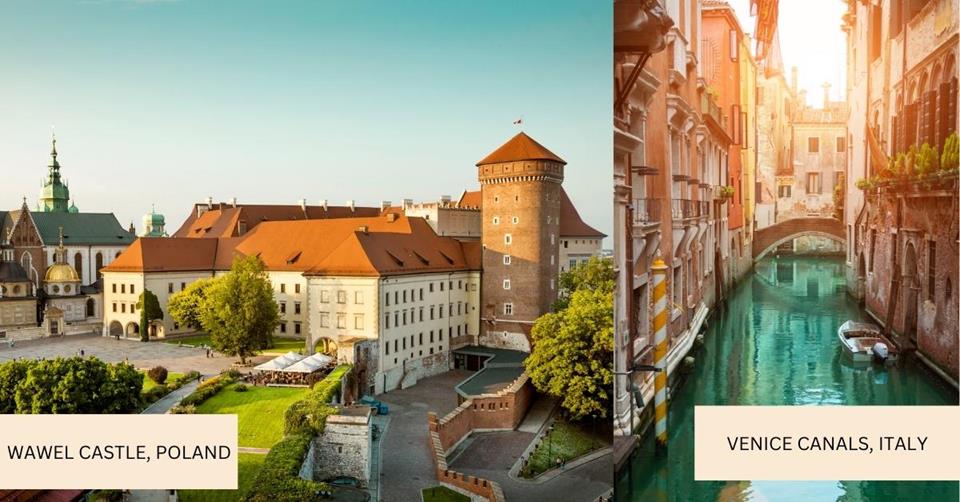
If you want to visit Europe during winter, consider visiting Portugal, Spain and Italy. These three are close to each other. They also have affordable accommodations and generally have fewer tourists during this season.
In Italy, you can enjoy the Colosseum without crowds, explore the mountains, and spend time in museums. You will also have the luxury of spending the entire 3 weeks in Italy, covering north to south. From mountains, vineyards, and historical places, to Mediterranean beaches. If you are foody, you definitely have to try these best Italian desserts.
On the other hand, Portugal doesn’t suffer from freezing temperatures even in the middle of the winter season, so you can still enjoy the sunlight and do various outdoor activities such as hiking. There are popular Instagrammable spots in Portugal that are worth a visit, and of course, wine and food.
You want to see Porto and Lisbon, especially if you want to hike the popular Santiago de Compostela route. Once you get to Porto, stay near a bus or metro stop, both budget-friendly ways to move around. If you don’t know where to stay in Porto, near the historic centre of Ribeira District, both offer affordable options.
Don’t forget Lagos; it offers such wonderful water activities. This is an incredible destination if you plan to visit during summer. Lagos is located in the Algarve region, a popular area for its coastal features. If the water is too cold during winter in the Algarve, there are other things you can do, such as hiking, visiting chapels, enjoy a road trip.
If you are heading to the capital, decide on the activities, from museums, beaches, hiking, and even night-out parties. Knowing what to pack for Lisbon will ensure you don’t waste your time and money. Check our itinerary for 3 weeks in Portugal.
Lastly, Spain holds some of the best festivals on the continent during this season. During winter, the best places to visit in Spain are Seville, Barcelona, Madrid, Granada, the Canary Islands, and Costa del Sol.
There are so many places to see in Madrid, and probably a good 5 days here is the perfect spot. At the same time, Barcelona for 2 days will allow you to cover too many attractions.
But please, do not miss the Canary Islands – like no other in Europe. We have 3 weeks in Spain. Below are the budget ranges you should allocate for food, guided tours and accommodation. You can also check out our 3 weeks in France, Italy, and Spain itinerary.
- food budget per day: $20
- guided tours cost per day: $15-$30
- accommodation cost per day: $25-$45 as a backpacker or $70+ for mid-range
- 3-week budget: $1,200-$1,800 (excluding flights to and back)
Mid-range – UK, France, Germany
If you want to spend more, visit the UK, France and Germany. These countries are rich in history and are close to each other, so much so that you can take trains to cross borders. They also have great wine and beers, so this option is perfect for wine and beer enthusiasts.
Check out our 3 weeks in Central Europe itinerary, which features Germany, Poland, Czechia, Switzerland, Austria, Slovakia, and Hungary. But if you prefer the West, we also have an itinerary for 3 weeks in Western Europe or a sole 3 weeks in Germany post.
If this is the region you want to visit, it’s best to come during the off-season, which is either from March to May or September to November. The prices are lower, and there are fewer crowds.
If you visit the UK, you can finally see Big Ben in London and London Bridge. You can spend your holiday in England, which hosts festive Christmas markets and drink hot chocolate while wandering about or seeing the world-famous Isle of Skye in Scotland.
There are many ways to explore the UK. We have a guide for 3 weeks in England only, or you can also explore the entire country and do 3 weeks in the UK.
However, if you have been to the UK before, you probably want to visit Ireland this time. You can combine Scotland, Northern Ireland, and Ireland. Please look at our 3 weeks in the UK and Ireland itinerary.
In France, you can take a picture of the Eiffel Tower or visit the Louvre if you’re a museum enthusiast. You can also try out their seasonal cuisines and go on a shopping spree as they have a government-mandated citywide sale during this season, also known as “soldes”. And yes, we have an itinerary for 3 weeks in France.
In Germany, you can go to thermal bathhouses to experience their outdoor pools and saunas. You can also ride their historic cable car, Merkurbergbahn, to see the snow-covered pine trees. Here are the daily price ranges for food, accommodation and tours.
- food budget per day: $25-$35
- guided tours cost per day: $30-$50
- accommodation cost per day: $35-$50 for backpackers or $80+ for mid-range
- 3-week budget: $1,900-$2,800 (excluding flights to and back)
Affordable Summer Destination – Italy, Croatia, Greece
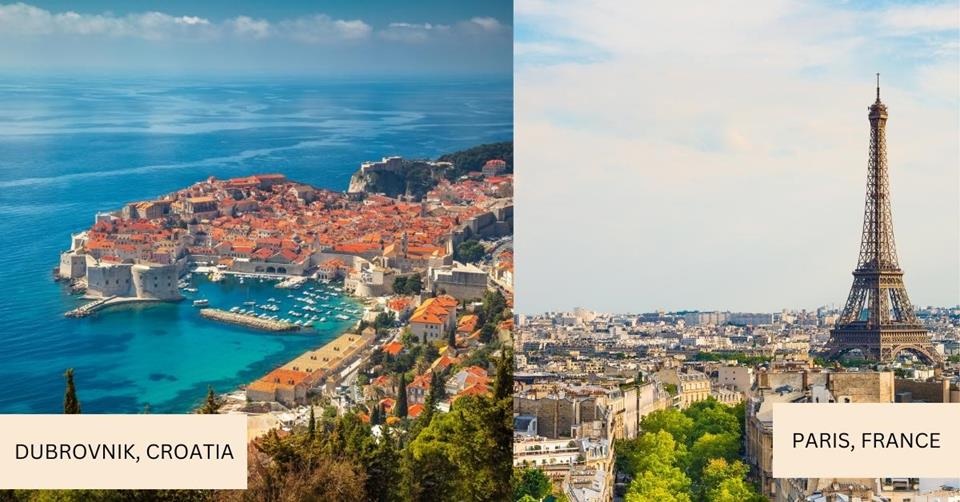
For affordable summer destinations, Italy, Croatia, and Greece are must-visits. They are not necessarily next to each other or affordable. Italy is expensive, but Greece and Croatia are a bit more affordable so that balances it out.
Another thing is that flights between these three countries are affordable. Plus, it’s in Southern Europe; there’s no better place for a beach vacation in this region.
These 3 destinations serve great food, wine, and beer and are rich in natural scenic spots like beaches and mountains. Personally, I would say this is the best way to explore Europe in 3 weeks on a budget.
Italy is known for their fantastic food. You can go on a gondola ride in Venice and have wine tastings in Sorrento, which sounds like a perfect summer getaway. Venice is not really a budget-friendly destination.
But, if you want to make this trip affordable, check out the coastal cities on the southeast side of Italy. Not only are they cheaper for vacation in this expensive country, but they are also less crowded.
Greece is a famous summer spot as well. You can visit Mycenae, an ageless arch made with monumental stones that was once a dwelling place of some of the most famous people in Grecian history, including Agamemnon, Electra, and Orestes. You can also have a road trip with your friends around Pelion or just chill and have a slow day in Hydra.
This country is an excellent choice if you want to experience the Mediterranean Sea but want to do Europe in 3 weeks on a budget. 3 weeks in Greece is a little more affordable than Spain, France, and Italy.
Croatia is now known for its location in Game of Thrones, but it has more to offer. You can go coral diving during the summer season. You can also avail yourself of a boat trip, hike, swim, cycle or sail; honestly, the sky’s the limit with the number of things you could do here.
It’s another more affordable destination but located ion on the Mediterranean Sea. You can check our 3 weeks in Croatia itinerary too or 3 weeks in Croatia and Greece combo.
- food budget per day: $20
- guided tours cost per day: $15-$30
- accommodation cost per day: $25-$35 or $50 and up for mid-range
- 3-week budget: $1,000-$1,800(excluding flights to and back)
Drinks and Beach – France, Poland, Greece
If you are the type of person who wants to lounge along the beach while drinking wine or beer, then this triad is perfect for you. Aside from that, these countries are rich in historical artefacts and landmarks, and flight tickets are cheap.
One of the most famous beaches in France is Plage de la Cote des Basques in Biarritz, which you’ve probably read about in Hemingway’s The Sun Also Rises. Another famous beach is the Deauville beach in Normandy, where Coco Chanel opened her first clothing store and held historical value.
Sopot is one of the most famous beaches in Poland, especially for the locals, because aside from chilling and sipping wine along the bay, you can also take boat rides, and there are spas and saunas nearby.
Swinoujscie Beach is famous for its water sports because of the constant wind and waves. It also has a windmill nearby which is considered its most famous landmark. Greece has the most beautiful beaches in Europe, so you won’t have difficulty looking for a great beach there. Some of the most beautiful beaches are Mykonos, Crete and Santorini.
- food budget per day: $25-$35
- guided tours cost per day: $30-$50
- accommodation cost per day: $25-$50
- 3-week budget: $1,700-$2,800 (excluding flights to and back)
CHECK-OUT: Best itineraries for 3 weeks in East Europe
A bit of splurge – Iceland, Norway, Denmark
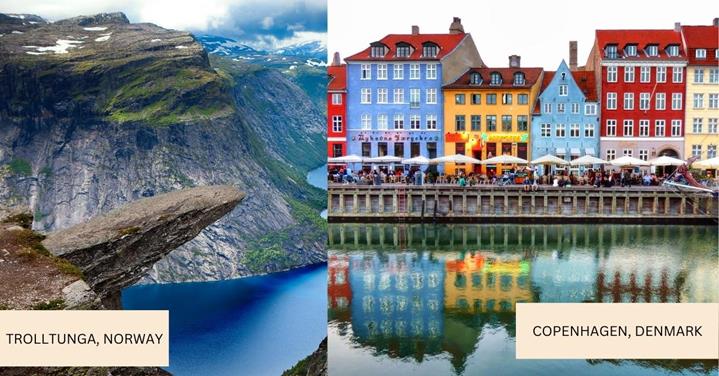
I know Scandinavia or the Nordic region doesn’t scream Europe in 3 weeks on a budget. But if you have a larger budget and want to splurge a little, Iceland, Norway, and Denmark are the perfect places to visit. The best way to make this plan affordable is to rent a car rather than relying on domestic flights, trains, or even buses.
Not super cheap, but it can be affordable if you plan and look for great deals. Remember these tips for visiting Iceland and travelling to Scandinavia for first-time travellers to this region.
You should look at flights and book accommodations 4-6 months in advance. Travelling in the northern hemisphere during the off-season, fall or winter, would be best.
Book hotels in advance to save money and also use local transportation. For instance, if you plan to go during the summer, flights are cheaper if you book them during the winter.
You can enjoy many free or affordable activities like hiking, sightseeing, or road-tripping. You can also enjoy their street foods at a lower price than at their restaurants.
If you are curious, some of the most famous places in Iceland include the Blue Lagoon in Grindavik, a geothermal spa and Strokkur Geysir, where spectacular geysers are found. You can also witness the northern lights if you’re lucky, as the time of their appearance is quite unpredictable.
Meanwhile, in Norway, you can visit the Lofoten Islands or the scenic city of Bergen, which form an archipelago and go to the Lofoten War Memorial Museum. Bygdoy Peninsula is also home to some of Oslo’s top tourist attractions.
In Denmark, you can visit the Tivoli Gardens found in Copenhagen and Nyhavn, the model of most postcards and can also be found in Copenhagen. Here, you will also see the statue of the Little Mermaid, yep, that story was written by the Danish writer, Hans Christian Andersen.
Do you know that you can spend 3 weeks in Scandinavia and cover Norway, Denmark, and Sweden on the same trip? We also have 3 weeks in Iceland itinerary if that’s something you have in mind and a Norway itinerary.
- food budget per day: $30-$50
- guided tours cost per day: $50-$70
- accommodation cost per day: $45-$60 for backpackers or $100+ for mid-range
- 3-week budget: $2,400-$3,500 (excluding flights to and back)
The Baltics – Lithuania, Latvia, Estonia
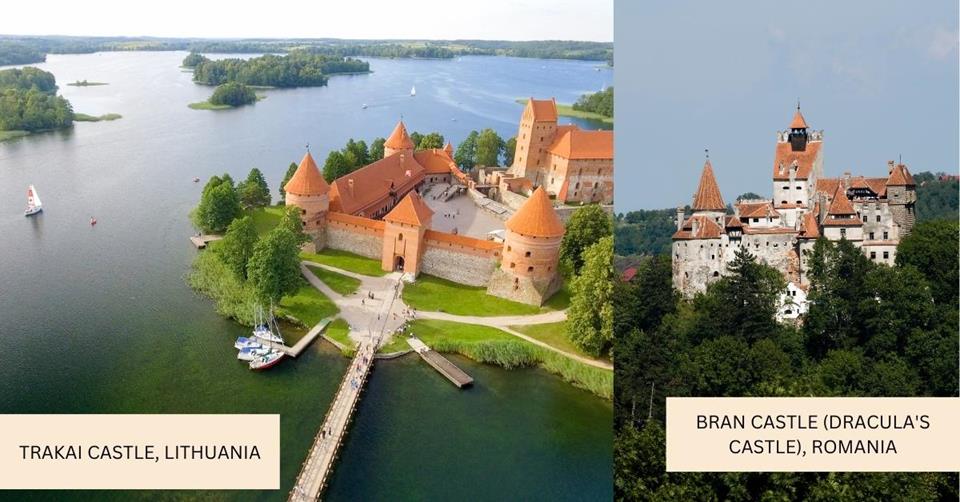
If I’m on a budget, these three countries are my favourite European destinations for Europe in 3 weeks. These places offer a calm and relaxing vibe, from beaches to hiking, to castles, without spending too much.
You can cross the borders via train or bus, saving you money instead of flying. I’m not going to lie. The Baltic beaches are not stunning, but they offer a tranquil scene and few tourists.
I recommend you enter either through Vilnius or Tallinn and make your way north or south. Don’t forget to try cider from this region. It’s one of the best in Europe. Few do this, but road-tripping through the Baltics is the best way to explore this area. It’s more affordable and gives you so much more freedom.
In Lithuania, make sure to visit Vilnius, Kaunas, and Klaipeda. These two cities offer different activities from one another. Vilnius for the cultural and historical experiences and the best nightlife in Lithuania. In comparison, Kaunas is known for its creative and street arts.
Even though it’s a small city, many things to do in Kaunas are related to art. Last but not least, Klaipeda for the beach and other water activities. Make sure to visit Trakai Castle and Uzupis.
From there, make your way to Riga, the coastal capital of Latvia. Enjoy museums, castles, fortresses, and the beach during summer. You can also visit Rezekne, where Raznas National Park is located. Here, you can enjoy hiking, fishing, and even canoeing.
And lastly, Tallinn. A vibrant and modern city, Estonia’s capital and known for being the leading digital powerhouse of the Baltics. Estonia is the pioneer of digital residencies and the first country to welcome digital nomads. Many museums show Estonia’s history and culture. Being on the coast, you can enjoy the beach during warm weather and other water activities.
- food budget per day: $15-$30
- guided tours cost per day: $15-$30
- accommodation cost per day: $35-$50 for backpackers and $60+ for mid-range hotels
- 3-week budget: $1,400-$2,300 (excluding flights to and back)
SUMMARY OF EUROPE IN 3 WEEKS
Europe might be expensive in general, but with enough planning and research, you should be able to create a travel plan for Europe without spending too much.
Our own guide to Europe in 3 weeks on a budget, consists of our personal list of places that I visited and perhaps you can visit them as well depending on your budget, season and activity preference.
These budget ranges are for participating in group tours and eating in bazaars, holiday fairs or mobile food carts instead of going to fancy restaurants.
Next summer, I plan to be in Europe for 3 weeks visiting Italy (can never get enough!, Slovenia, and Czechia.
We hope reading this has been enjoyable and informative for you as much as compiling this list has been delightful. We also hope you would consider going to Europe because there are many famous scenic spots and hidden gems just waiting to be visited.
SAVE THIS TRAVEL ITINERARY ON YOUR PINTEREST:
